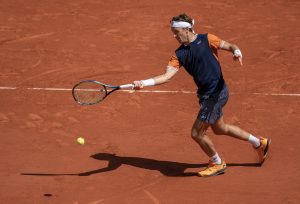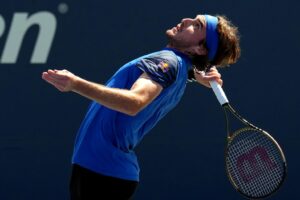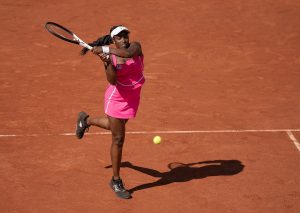With the US Open well-underway, we here at LWOT are taking our annual look back at some of the top matches from previous eras.
Today, we review the 2000 semifinal US Open semifinal: Pete Sampras vs Lleyton Hewitt. Two players who provided a great contrast in styles of play, an era where this was possible; and welcomed. Hewitt was the precocious teenager possessing bundles of energy, with the knack of annoying senior pros. Hewitt was loud and in the face of his opponents a lot. In fact, it was reported in 2000 that several Spanish players had threatened to punch him out in the locker room.
Undeterred, Hewitt made a dramatic rise up the rankings. He won his first title in 1998 as a 16 year old, surprising Andre Agassi in Adelaide. In 2000, Hewitt won his first grass title in Queens, beating a lethargic Sampras in the final. Going into this US Open, Hewitt was seeded ninth and reached the semifinal by dispatching Thomas Enqvist in the fourth round and Arnaud Clement in the quarterfinals.
Sampras went into the hardcourt season basking in the limelight of breaking the grand slam record at Wimbledon. A 13th major title won against Pat Rafter put Sampras on top of the world once again. And, he looked set at age 28 to extend his career at the top. Sampras took a well-earned break to recover from the shin injury which hindered him at Wimbledon. However, the summer didn’t work quite to plan. Quarterfinal defeats to Marat Safin in Canada and Tim Henman in Cincinnati meant Sampras went into the US Open undercooked.
But he played his way into the tournament. And after a brilliant four set victory over Richard Krajicek in the quarterfinal, Sampras was in good form for the semifinal vs Hewitt. This was the fifth meeting between Sampras and Hewitt with Sampras holding a 3-1 lead. As mentioned, Hewitt won the Queens final relatively easily while Sampras handled Hewitt in the Miami semifinal. It promised to be a good match as it was the classic puncher v counterpuncher scenario. But with the added twist that unlike many other serve volleyers, Sampras liked to rally. The match started with Sampras holding serve and Hewitt replied in kind, although with interest, Hewitt hit three aces in his first service game.
Sampras, meanwhile, hit two incredible stop volleys off two hard hit backhands, the standard was high. Hewitt manufactured a break point early with a return which landed on the line but Sampras saved breakpoint well. At 4-5 in the first set, Sampras saw the time to pounce, as champions tend to do. He played a brilliant point to make it 15:30 then played a point you don’t see in today’s tennis. Hewitt missed the first serve and hit a good second serve into the body which Sampras fended off.
Hewitt then hit a good deep shot but with a semi open stance, Sampras fired a forehand from behind his baseline right in the corner, Hewitt completely flat footed. Sampras’ shot was full of spin and yet seemed to travel around 90mph. This merited two set points but Sampras was unable to convert. Hewitt again employing the body serve which worked, leaving Sampras frustrated. Sampras created another set point but Hewitt saved that as well. Sampras held serve to go 6-5 up.
Then Hewitt reached the tiebreak but not before saving yet another set point, four in total. The tiebreak started with Sampras getting broken but retrieved the mini break with a brilliant forehand, taking advantage of a short ball by Hewitt. After another exchange of mini breaks, Hewitt found himself set point up on his serve. Hewitt was unable to convert with a mental error, missing his forehand well wide.
Perhaps he got too excited but also wanted to stay away from the Sampras forehand. This let Sampras back in who went up a mini break himself after yet another brilliant forehand. This time inside out from his backhand corner, right on the line. Sampras served out with a missed return by Hewitt to take the tiebreak 9-7. It was a close set but with four missed set points in open play, Sampras deserved the set.
The second set started off with Sampras securing an early break, establishing control of the match. This was interesting because Sampras really ramped up the pressure on Hewitt, going to net more and attacking anything short by Hewitt in the rallies. Sampras had the opportunity to go two breaks up, particularly with four stunning forehands which commentator Chris Bailey described as “ridiculous”. Although Sampras didn’t convert he played an incredible slam dunk smash which resembled a hurdler’s jump in athletics. Sampras seemed to treat the second set like an exhibition and Hewitt was not in the game, just hanging on. Sampras served out the second set to love, with a second serve ace on the line at 111mph. Just to validate his superiority.
With Sampras two sets up, he was on course to make the final, but in sport there is usually a twist. Hewitt started the third set hitting four aces in a row! He was not going anywhere. Sampras played an amazing first point on his serve with included a high backhand overhead which has a degree of difficulty of 10. However, surprisingly Sampras was finally broken, which left him visibly frustrated. Hewitt thinking he could take it to four sets, and then see if he could get to a fifth. No long fifth sets at the US Open so there would be a quick conclusion.
By the way, if Hewitt was thinking that far ahead, he shouldn’t have bothered because he handed the break straight back to Sampras at 4:2. In what can only be described as a mental error, he served to Sampras’ forehand twice in the ad court. Sampras obliging with clean winners, each time. Hewitt showed his inexperience. With the third set at 4-3 and back on serve, Sampras was able to take it to a tiebreak, the second of the semifinal.
Hewitt started off with a double fault but Sampras replied with one of his own. At 2-2 Sampras hit a big forehand and came into net with a decent stop volley. However, Hewitt was there to either push it down the line or crosscourt, Hewitt went crosscourt but plonked it in the net. At which point Hewitt took the second ball out of his pocket and smashed it into the net in frustration. But again, Hewitt came back with an incredible backhand crosscourt passing shot, one of many he hit in the match.
There is no doubt Hewitt was blessed with fast twitch fibres which helped him the most on faster courts. Not dissimilar to Angelique Kerber, who also never performed as well on clay, he didn’t have enough natural power of their own. At 4-5 Sampras played the best two points of the tiebreak and probably the match. He hit a second serve down the middle which Hewitt returned beautifully right at his feet. Sampras had the presence of mind to hit a backhand half volley right into the corner, pushing Hewitt back, then finished with a forehand volley at net off an attempted passing shot. Perfect tennis.
To set up match point, Sampras hit a serve down the middle, Hewitt’s return went high and would have fell just inside the baseline, but Sampras took it out of the air head height and swatted it away like it was nothing. Probably one of the greatest smashes ever hit on a tennis court. This set up match point, which Sampras capitalised on Hewitt’s serve, with two big inside out forehands in a row, forcing Hewitt to slice the ball in the net. Result 7-6 6-4 7-6 to Sampras.
For a match which was only three sets in length, it was a very high quality. Even though Sampras made a large number of errors, he was forcing the play. The stats show that Sampras hit 62 winners and made 41 unforced errors. Out of the winners 27 were forehands which is incredibly impressive. Hewitt hit 45 winners of his own and only made 15 unforced errors which is equally impressive.
Sampras would go on to a very surprising straight sets defeat to Marat Safin in the final. A big shock which was viewed as the beginning of the end for Sampras as top dog in tennis. Hewitt would become number 1 in late 2001, achieving that after taking revenge on Sampras winning the US Open. In fact, Sampras would never beat Hewitt again, Hewitt taking the last four meetings to finish 5-4 in his favour. Sampras’ demise coincided with Hewitt’s rise. The abandoning of his baseline game throughout 2001 and some of 2002 played into Hewitt’s hands. Sampras’ forehand was too much for Hewitt but his change of tactics to chipping and charging did not work against a player with fast twitch fibres and a great return of serve.
Main photo:
Embed from Getty Images






